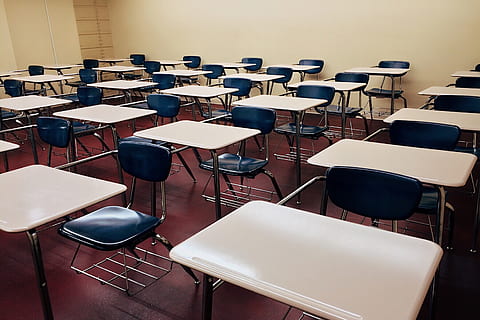Teachers’ responses to student’s homecoming sign

image of empty classroom full of desks taken by Piqsels
October 5, 2021
The Monday following homecoming, faculty had a meeting to discuss an incident regarding a student’s homecoming poster. With little guidance teachers were left to decide how they would address the incident in their classes. Since then, teachers and students alike have brought up the topic, sparking discussions, and creating outlets for individuals to express their thoughts on the subject. The way in which these conversations were initiated and managed however, varied from teacher to teacher.
“I haven’t necessarily addressed it, I just said [if] kids bring it up we would talk about it, and say that’s not who we are and, that wasn’t wise,” Math Teacher, Michelle Kinzer said.
Kinzer shared wisdom that she has gained from her own experiences with tragedy.
“We can never punish people enough to feel better. We really can’t, and if you’ve ever been really wronged, then you know that. Nothing will make you feel better. Then, how do you try to make restitution? But then also, how do you learn to forgive,” Kinzer said “I can’t apologize for them, but I can try to live an appropriate life myself, and to love the people around [me].”
While many teachers have let students start the conversation, others have decided to take it upon themselves to bring up the topic. Matt Croft teaches a Contemporary Issues course, so on Monday, the majority of his classes were spent discussing the subject.
“[We] spent 30 minutes or so of our class talking about what happened, getting thoughts about the students’ opinions on what we heard, and then discussing ideas as a class and as a community, how we can move on and learn from these mistakes,” said Croft.
In the way of guidance, the district tried to ensure that the individuals involved were being protected from a legal standpoint.
“There was direction given by the district on how to handle it, specifically information given on legally, what could be said and couldn’t be said. So giving some guidance on the law, and what we could address specifically related to punishment, consequences, and what we publicly can’t share because of privacy concerns,” Croft explained.
In regards to discussion among students outside of class, Croft gave insight into what he’s been hearing.
“I would say when I address it in class, [we focus] more on what we can do to move on and build upon [the incident], but with just the students I’ve heard a lot of the ‘hating’ on the student. I’m not sure I would phrase it that way, but the negativity towards the individual,” Croft said.
English Teacher and Department Chair, Marc Gibbens, explained how he approached the situation in his classes.
“The most important thing I have done is talk about it.” he said “Fortunately, I was teaching a text, that at the time was incredibly relevant. There’s a quotation in part one of Fahrenheit 451 that says, ‘[w]e need not to be let alone. We need to be really bothered once in a while… about something important, about something real,’ and so I used that as sort of an access point to say, hey, this thing that really bothered me happened over the weekend,” Gibbens said.
“We’d had a faculty meeting in the morning before school and our principal had said we don’t want to just brush this under the rug, we want to address it. And so I shared my thoughts on it. It’s a really offensive poster, and something that caused a lot of hurt and harm to minority students in our building,” he said
Gibbens’ also brought up a comment from a student in his seventh hour class.
“[The student] said the most disturbing thing about this, is that [they] made it all the way through [their] day, and no other teachers had talked about it in class,” he said. “It’s the responsibility of our whole community to try to do better,” Gibbens said.
